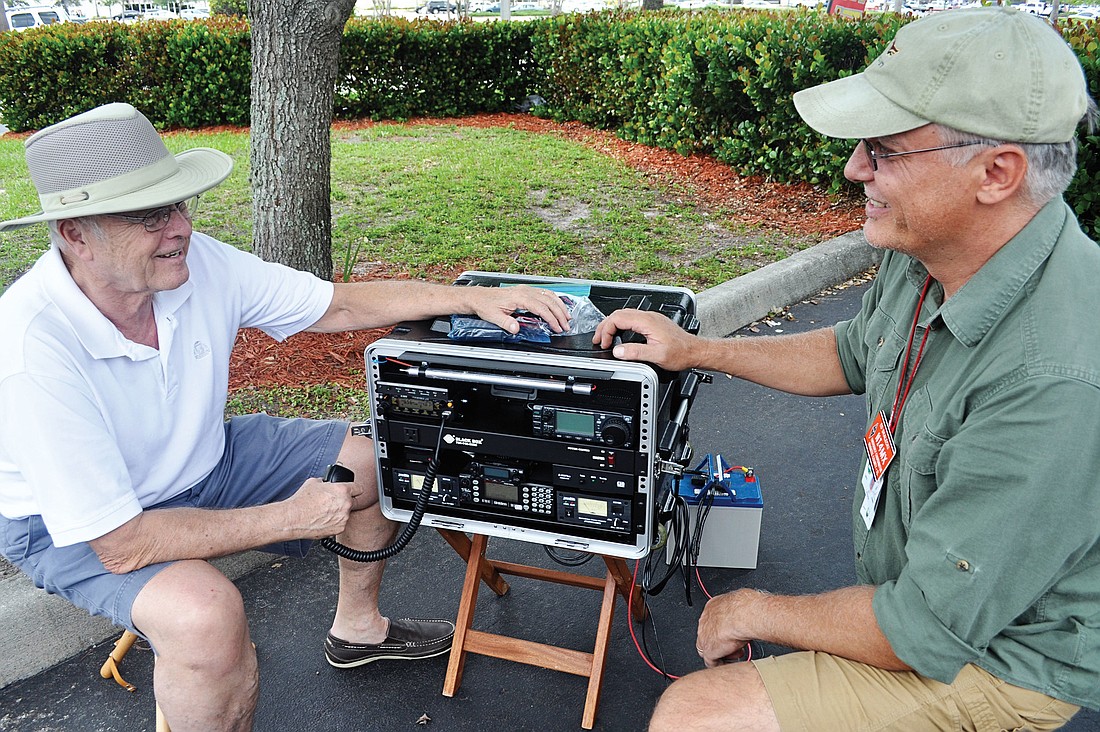- April 17, 2024
-
-
Loading

Loading

LAKEWOOD RANCH — Amateur radio operators know their services probably will not be needed.
Their very nickname — hams — pokes fun at their amateur status.
But, they prepare as if their service is vital, because it is.
Nearly 14 years ago, Roger Byron, a Vietnam War veteran, served as an amateur radio operator for SKYWARN, a severe weather-spotting network.
A storm brought heavy rain, hail, funnel clouds and lightening to Anna Maria Island. Using his radio on scene, Byron recorded and reported every inch of rain to the National Weather Service. He measured 12 inches of rain in eight hours.
Today, as he has for the last 10 years, Byron uses those skills as a volunteer amateur radio operator.
This weekend, he and other members of the Amateur Radio Emergency Services, or ARES, a national organization organized by the American Radio Relay League, will join amateur radio enthusiasts worldwide, as they hone their skills during an annual Field Day event June 22 through June 23.
Volunteers practice their emergency-improvisational skills by using hundreds of frequencies and establishing networks to communicate to other radio operators across the country.
“Are we going to be used?” said Ed Skalecki Manatee ARES’ emergency coordinator. “Probably not. We hope to never be used. That means something bad happened.”
But, when the Manatee County Emergency Operations Center (EOC) asks, Manatee’s roughly 40 ARES members are ready to respond to emergencies with their radios, the fastest means of communication when landlines, cell phones and other communication efforts fail.
Skalecki, organizes the hams and dispatches them to emergency events.
“We do this because we get a sense of being useful,” Skalecki said. “This is not something you get in for for notoriety or credit. It’s just self-gratification.”
They are science guys who get excited by words such as “ionosphere,” the region in the upper atmosphere that guides the behavior of radio waves.
They love how amateur radio signals can be dispersed, even when cellular towers are overloaded.
The men participate in self-run contests to see who can communicate with the most countries at one time using their radios.
Disaster mobilization starts when Skalecki runs check-ins to find out which of his operators are available. The EOC governs who does what.
Community Emergency Response Teams, called CERTs, usually are already on scene, assessing damage, such as the number of dead or injured people.
If the CERTs’ communication to the EOC fails — for example, if cell phone networks are out or overloaded — hams communicate to the EOC, using radios, for them.
If a shelter is out of water, the EOC contacts Skalecki to find a ham who can replenish it. Or, the EOC might need to know how many people are being served inside each shelter.
Once, Skalecki sent Byron to Braden River High School, which was a shelter during Hurricane Charlie.
He registered people who sheltered there and took inventory of available meals.
Sometimes, operators will be called to direct traffic on street corners for weather-induced traffic. They assess damage themselves, assisting undermanned CERTs with reporting downed power lines and uprooted trees.
When Skalecki dispatches Bryon to an event, Byron packs his go-box into car. It contains six radios, some used to communicate digitally and others only vocally. Some require the user to communicate via Morse code.
Byron comes equipped with antennas and a power supply he plugs into the wall. When the power goes out, the power automatically switches to battery.
He attaches a small video camera to one of the radios so he can send storm video footage to the Manatee County Emergency Operations Center (EOC).
When he’s not dispatched, Byron sits on a stool by his radios, ready for anything.
Earlier this month, during Tropical Storm Andrea, the EOC told Skalecki to have his men on standby to activate shelters. The EOC ended up not requiring their services.
“We are not asked to go into danger,” Byron said. “We do what is within our training.”
When there’s nothing to do, the hams find something to fill their time.
During an annual bike ride for diabetes in Lakewood Ranch, some hams volunteer to man check points, looking to fill flat tires and hydrate tired bikers.
“We’re trained to be faster than everybody else,” Skalecki said. “And, by nature, radio is fast. And, we are (the fastest).”
Contact Josh Siegel at [email protected].
IF YOU GO
Amateur Radio Field Day
When: Noon Saturday, June 22 through 3 p.m. Sunday, June 23
Where: Living Lord Lutheran Church, 11107 Palmbrush Trail, Lakewood Ranch
What: Amateur radio operators worldwide will participate in an annual Field Day, during which volunteers practice their emergency-improvisational skills by using hundreds of frequencies and establishing networks to communicate to other radio operators across the country.
A group of local operators will set up their antennas and solar-powered radios on the lawn of Living Lord Lutheran Church, in Lakewood Ranch.
They will communicate to other operators, called hams, at parks, malls, schools, churches and yards around the country by using voice, digital and satelitte communications and even Morse code.
The general public can use radios under the supervision of a radio operator.